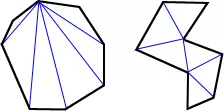Octagons are fascinating polygons that have eight sides and eight angles. In this article, we will dive into the world of octagons, exploring their different types and properties.
What is an Octagon?
An octagon is a closed 2D shape that consists of eight sides and eight angles. It is a versatile shape that can take on various forms, depending on whether it is regular or irregular.
Octagon Shape
The shape of an octagon can vary greatly. An irregular octagon can have eight sides and eight angles, but its shape can be almost anything. On the other hand, a regular octagon has sides of equal length and angles that are all the same. An everyday example of a regular octagon is a stop sign. Let's take a look at some examples of irregular and regular octagons:
 Fig: Examples of irregular and regular octagons
Fig: Examples of irregular and regular octagons
Octagon Types
Octagons can be classified as either regular or irregular and concave or convex.
Regular Octagon
A regular octagon has sides that are equal in length and angles that are equal in measure. Each interior angle of a regular octagon measures 135°, and each exterior angle measures 45°. The opposite sides of a regular octagon are parallel.
Irregular Octagon
If not all sides and interior angles of an octagon are equal, it is considered an irregular octagon. The shape of an irregular octagon can vary.
Convex Octagon
A convex octagon is one in which no line segment between points passes through the octagon. The interior angles of a convex octagon are all less than 180°. Note that a regular octagon is also a convex octagon.
Concave Octagon
A concave octagon is one in which it is possible to draw a line segment between two points such that the line segment crosses the inside of the octagon. To be a concave octagon, one or more of its interior angles must be greater than 180°.
Octagon Properties
Let's explore some properties of octagons in general and some specific to regular octagons.
Properties of all Octagons
- Octagons have 8 angles, 8 sides, and 8 vertices.
- The sum of the interior angles of an octagon is 1080°.
- The sum of all exterior angles of an octagon is 360°.
- An octagon has 20 diagonals.
Properties of Regular Octagons
- All 8 sides of a regular octagon are equal.
- All 8 angles of a regular octagon are equal.
- The interior angles of a regular octagon each measure 135°.
- The exterior angles of a regular octagon each measure 45°.
Octagon Formula
Here are some formulas for finding the area, perimeter, and diagonal length of a regular octagon.
Area of a Regular Octagon
The area of a regular octagon with side length s is calculated as:
Area = 2 (1 + √2) s^2
To visualize this, you can extend the four non-adjacent sides of a regular octagon to create a square. This square forms four 45-45-90 right triangles on its corners. By calculating the area of the square and subtracting the areas of the four right triangles, we arrive at the formula mentioned above.
Perimeter of a Regular Octagon
The perimeter of a regular octagon is simply the sum of all its sides. If the octagon is irregular, the perimeter is the sum of all the sides.
Diagonal of a Regular Octagon
The length of the diagonal formed by joining two opposite vertices of a regular octagon can be calculated using the following formula:
Diagonal Length = s * √2
Diagonals of an Octagon
An octagon has diagonals, which are line segments joining two non-consecutive vertices. There can be five diagonals drawn from each vertex, resulting in a total of 20 diagonals for an octagon.
Interior Angles of an Octagon
The sum of the interior angles of an octagon is 1080°. To understand this, we can divide the octagon into six triangles by drawing five diagonals. The sum of the interior angles of these six triangles is equal to the sum of the interior angles of the octagon, which is 1080°.
Symmetry in Regular Octagons
A regular octagon exhibits symmetry in fascinating ways. It has eight lines of symmetry and a rotational symmetry of order 8. This means that the octagon can be rotated in such a way that it looks the same as the original shape eight times in 360°.
 Fig: Regular Octagon with Rotational Symmetry
Fig: Regular Octagon with Rotational Symmetry
Octagons are intriguing shapes that appear in various contexts. Whether you're exploring geometric concepts or simply appreciating their beauty, understanding the properties of octagons enhances our knowledge of the world around us.












